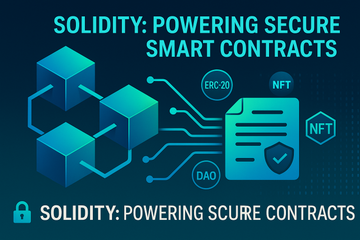Picture this: you’re at a digital flea market, wheeling and dealing without ever shaking hands, signing papers, or even seeing the other party’s face. Just lines of code, humming away, keeping everyone honest. That’s not science fiction—that’s the reality of smart contracts. And at the heart of it all sits a programming language called Solidity.
Solidity—Coding in the Crypto Wild West
Let’s get one thing straight: Solidity isn’t just another programming language. It’s the workhorse behind Ethereum and a handful of other blockchain platforms, responsible for making smart contracts actually happen. Written in a style a bit like JavaScript or C++, but with its own quirks (and, let’s be honest, a few oddball behaviors), Solidity empowers developers to write self-executing agreements right on the blockchain.
Why does that matter? Well, think about the trust issues that come up in real-life deals. Paper contracts can be lost, lawyers get expensive, and misunderstandings are practically guaranteed. Solidity-powered smart contracts skip all that drama. They’re like vending machines for agreements—put your parameters in, and out comes a result nobody can mess with.
So, What’s Solidity Really Like?
If you’re a coder, Solidity offers familiar ground—a little object-oriented structure here, a dash of inheritance there. But it’s got a blockchain twist. Instead of fiddling with databases on some regular server, you’re programming logic that lives forever, visible to anyone with an internet connection and some cryptocurrency curiosity.
- Syntax: Solidity feels a bit like JavaScript, if JavaScript got serious about finances.
- Security: One typo or logical oversight, and your smart contract might get drained by hackers. Talk about high stakes.
- Immutability: Once it’s on the blockchain, it’s there for good. No edit, no undo. Honestly, it’s brutal and beautiful at the same time.
But here’s the twist—since smart contracts are static once deployed, you’ve got to get it right the first time. Like painting a mural that you can never fix, every brushstroke (line of code, in this case) counts.
What Can You Do With Solidity?
Plenty. And that’s putting it mildly. Solidity lets you do all kinds of financial wizardry without ever leaving your chair. From launching your own cryptocurrency to crafting complex decentralized apps (dApps) that rival mainstream tech behemoths, it all starts with a handful of functions and structs.
- ERC-20 tokens? Solidity.
- Automated loans and lending platforms? Solidity again.
- NFTs (Non-Fungible Tokens—the digital trading cards of today)? You guessed it, Solidity’s under the hood.
And it’s not all just get-rich-quick schemes or pixelated cat collectibles. Solid business applications and entire new models of governance (DAOs, anyone?) rely on Solidity smart contracts to run smoothly and fairly.
Should You Learn Solidity?
You know what? If you’re a developer who enjoys puzzles, has a cautious eye for detail, and likes the idea of changing how the world trades value, then Solidity is calling your name. The catch? The learning curve is real. And the pressure’s high; bugs aren’t just embarrassing, they can cost millions. No pressure, right?
But let’s look at the bright side—Solidity developers are in hot demand. The crypto world just keeps growing, and trustworthy code is at a premium. If you’ve got the guts and the patience, diving in now means you’re future-proofing your skills… or as close as you can get in tech.
Security First—Seriously!
We can’t talk Solidity without talking safety. After all, there have been more than a few high-profile disasters—remember the DAO hack? Code was buggy, and poof, millions vanished. It was a mess, and nobody wants a repeat.
Want to avoid becoming a cautionary tale? Test your contracts thoroughly—use tools like Remix for poking and prodding your Solidity code, and peer into the wild world of MythX or Slither for automated security analysis. And don’t try to reinvent the wheel every time. Working with well-established patterns (OpenZeppelin is a godsend here) can make you sleep at night.
One more thing: hardware wallets like Trezor or Ledger aren’t just for coin hoarding; use them to sign contract deployments safely. Nobody likes waking up and realizing their private key’s been stolen.
Building for the Future—What’s Next?
Solidity moves quickly. The language keeps evolving as blockchain itself grows up. Features get added, oddities get smoothed out, security becomes tighter (thank goodness), and the community just keeps tinkering. Platforms like Ethereum 2.0 and layer-two solutions are raising the bar for scalability and environmental friendliness. Solidity developers are finding new ways to make contracts more powerful, less expensive, and—dare I say—almost enjoyable to work with.
Even folks without a traditional programming background are slowly finding entry points. Tools like Truffle Suite and Hardhat are streamlining deployment and testing; tutorials and NFT projects are bringing in new waves of curious creators. It’s become less exclusive and, honestly, more exciting.
So, Does Solidity Have Staying Power?
Here’s the thing: as long as people want to ditch the middleman, trade assets, or navigate decentralized worlds, Solidity is hanging around. Yes, there are challengers to its throne (looking at you, Vyper and Rust-based chains), but right now, Solidity holds the keys to the Ethereum kingdom—and that’s no small thing. It’s a bit like being fluent in English for global business: it doesn’t cover everything, but it’ll open doors you didn’t even know were there.
Will you face headaches? Absolutely. Is it worth it? For many, the answer is a resounding yes.
Wrapping Up With a Wink
Solidity isn’t just for cryptographers or Wall Street escapees. It’s for anyone who believes that code can be fair, trustless, and sometimes even fun. Whether you’re daydreaming about the next outlandish NFT drop or tackling serious business infrastructure, Solidity is your ticket to the blockchain party.
And who knows? Next time you automate something that used to take armies of lawyers or mountains of paperwork, you might just catch yourself smiling. After all, it’s not every day you get to change the rules—and the very code—of the game.











